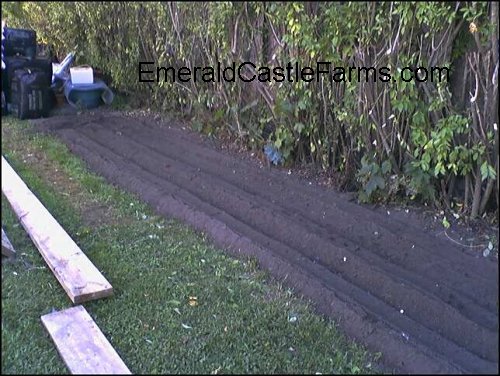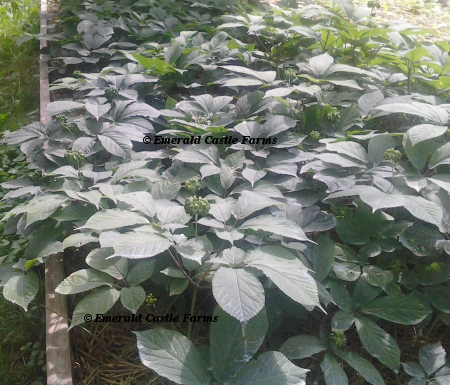Making Raised Beds for Ginseng
and Other Woodland Plants
The first step is to decide on a location for your bed. In the picture below, you will see the location of the beds next to a tall hedge row. The hedge is on the west side of the new beds. Next, we decided to till up the ground under the new raised beds.

In this case, each of the beds will be four feet wide and sixteen feet long. Set the sides of the beds in place and fasten them together. We are using a special self-taping torx head screw specifically designed for decking material. We are also using treated 2 x 10 lumber for the sides. Note also that we have sprinkled some Kocide (metallic copper) fungicide over the bottom of the new beds.

It is now time for the soil. First, throw in a couple inches of coarse sand to provide drainage. A good growing mix for ginseng is primarily peat with sand mixed in. A little hardwood mulch or sawdust won't hurt at all, and in all likelihood may help. In these beds, we used five or six large bails of Canadian red peat and mixed in about a half pickup bed of mason sand along with the other ingredients. You might also wish to add some gypsum or phosphorus at this point. Notice the small stakes used to keep the long sides of the beds from bowing out as they are being filled and the ingredients are being mixed with a small tiller.

You will need to wet down the peat and let it soak some to make sure the whole bed is evenly moist. Do this ahead of time so there is plenty of time for extra moisture to dry or run off. For nursery beds like these, I often use a modified rake to make rows about two inches apart. I then broadcast the seeds heavily and lightly use a leaf rake to cover the seeds. I am partial to shredded maple leaves for mulch and this is what you see in the next picture. This picture was taken after it rained, and you will also see some goldenseal starts in the end of the beds that haven't yet been mulched. If you don't have a shredder or maple leaves, clean straw is the next best thing.

Before your ginseng starts to come up the next spring, you should have some sort of shade ready to go. This was an experimental bed and I tried 3/4" plastic piping to create the framework for the shade. I just cut the pipe into five foot sections, then cut some small pieces about two inches long to use between the tees that hold fit onto the legs. Put them together without glue and they are easy to take down and up again. I put a small piece between two tees, and then attached two five foot pieces for the legs in an upside down V shape. After you get several sets of legs together, attach them along the top (the point) with five foot pieces. Simple isn't it? In this case, I also added some cross members to stiffen the legs and to put another horizontal piece in front to hold the camo netting away and shade the plants better. Then, I used military surplus camo netting for the shade. I've had good luck using this type of netting, but it does become brittle and less usable after a few years. Its advantage is that it is relatively cost effective for small amounts. You can cut and zip tie it back together as needed. And, you can buy it on Ebay. Just zip tie it to your frame and leave one side lose so you can roll it up and get to your beds.

With a little luck, some good seed and good weather, next spring will find your beds full of healthy ginseng and other woodland plants. Note the electric fence which became necessary to keep the local critters from digging in the beds. A couple weeks is all it took. Also be sure to understand that these are nursery beds. These beds are planted WAY too heavily to grow these plants to maturity. Planting this thickly will nearly always guarantee disease issues and will absolutely guarantee the need to spray diligently to prevent losses to fungal diseases.

Here is the same bed two years later.

Good luck and God bless!
~Brad